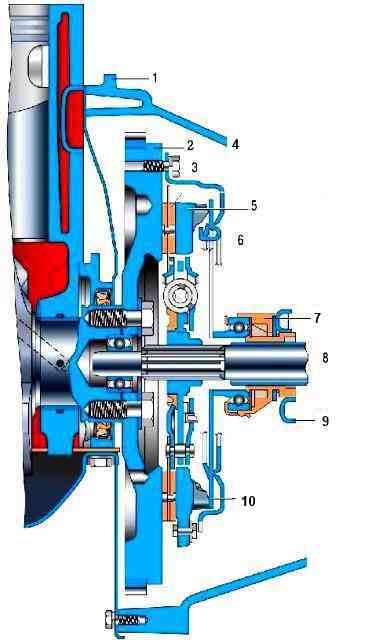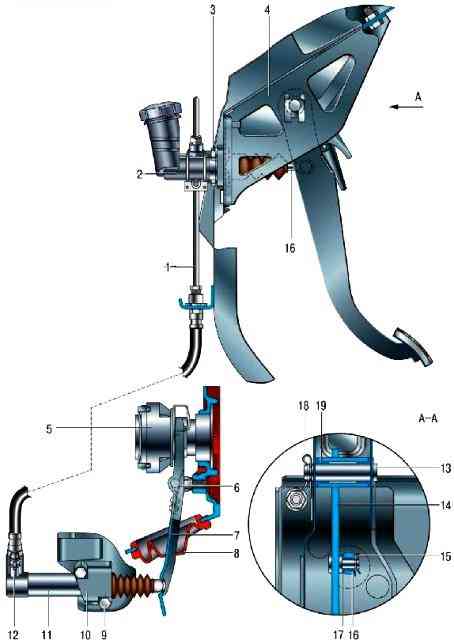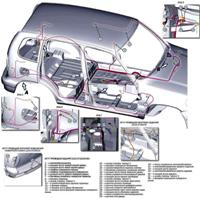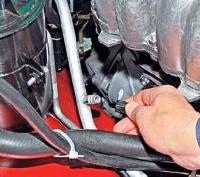The car has a single-disk, dry, permanently closed clutch with a central diaphragm spring
The clutch device is shown in fig. 1.

Clutch drive hydraulic, backlash-free, with automatic wear compensation of the friction linings of the driven disk.

The drive consists of the main 2 (Fig. 2) and the working 11 cylinders, the clutch pedal, the tube 1 of the hydraulic clutch release and the hose.
For a long and trouble-free clutch, do not constantly keep your foot on the clutch pedal.
This bad habit is often acquired while learning to drive in driving schools for fear of not having time to disengage the clutch while the car is stopped.
In addition to the rapid fatigue of the foot, which is all the time above the pedal, the clutch is at least a little, but squeezed out, and the driven disk slips and wears out.
In addition, although the release bearing is designed to operate in constant rotation mode, it is under increased load when the pedal is pressed a little, and its life is reduced.
For the same reason, we do not recommend keeping the clutch off for a long time (for example, in traffic jams).
If you don't have to move right away, it's best to put the transmission in neutral and release the pedal.
Clutch slip is easy to determine with a tachometer.
If, while driving, with a sharp press on the accelerator pedal, the speed rises sharply, and then drops a little and the car starts to accelerate, the clutch needs repair.
Checking the technical condition of the clutch
Check the technical condition of the clutch in the following ways.
1. Engage the neutral gear in the gearbox, start the car engine and warm it up to operating temperature.
When the engine is running at minimum engine speed, disengage the clutch (depress the pedal) and engage reverse gear.
The transmission should turn on without grinding, knocking or other extraneous noise.
2. Change gears while driving. All gears must be engaged without grinding, knocking or other extraneous noise.
3. When accelerating the car, proportionality should be observed between an increase in the engine speed and an increase in the speed of the car (the clutch should not “slip”).
Clutch slip is easy to determine with a tachometer.
If, while driving, with a sharp press on the accelerator pedal, the speed rises sharply, and then drops slightly and the car starts to accelerate, the clutch needs repair.
If these signs of normal clutch operation are absent, try to remove air from the clutch hydraulic actuator.
If bleeding the hydraulic drive does not lead to the desired result, remove the clutch for repair.
Possible clutch failures, their causes and remedies
- Cause of malfunction
Remedy
Incomplete clutch disengagement (clutch "leads")
- Warping of the driven disk (end runout more than 0.5 mm)
Straighten the disc or replace with a new one
- Loose rivets or breakage of the friction linings of the driven disk
Replace driven disc assembly
- Jamming of the hub of the driven disk on the splines of the input shaft
Clean the splines, rinse with white spirit.
If the splines are worn, replace the input shaft or driven disc
- Air in the clutch hydraulic system
Bleed the system
The stroke of the slave cylinder must be at least 24 mm
- Fluid leakage from the hydraulic drive system through connections or damaged pipelines
Tighten connections, replace damaged parts, bleed hydraulic system
- Fluid leakage from the master cylinder or slave cylinder of the clutch release
Replace seals or replace cylinder assemblies, bleed the system
- Skewed or warped pressure plate
Replace clutch cover with pressure plate assembly
- The runout of the pressure spring petals is more than 0.8 mm
Replace clutch cover with pressure plate assembly
Incomplete engagement of the clutch (clutch slips)
- Increased wear or burning of the friction linings of the driven disk
Replace driven disc assembly
Oiling the friction linings of the driven disk, flywheel surfaces and pressure plate
Rinse the surfaces thoroughly with white spirit, eliminate the causes of oiling of the discs
- The compensation hole of the master cylinder is clogged
Flush the cylinder, clean the compensation hole, bleed the system
Damaged or seized clutch release actuator
Remove causes of jamming
Replace damaged parts
Clutch jerks
- Jamming of the hub of the driven disk on the splines of the input shaft
Clean the splines, rinse with white spirit
If the splines are worn, replace the input shaft or driven disc
- Lubrication of the friction linings of the driven disk, flywheel surfaces and pressure disk
Rinse oily surfaces thoroughly with white spirit, eliminate the causes of oiling discs
- Jamming in the clutch release mechanism
Replace damaged parts, remove causes of seizing
- Loosening the rivets of the friction linings of the driven disk
Replace driven disc assembly
Surface damage or warping of pressure plate
Replace clutch cover with pressure plate assembly
Increased noise when disengaging the clutch
- Wear, damage or leakage of grease from the clutch release bearing
Replace clutch release with bearing assembly
- Wear of the front bearing of the input shaft of the gearbox
Replace bearing
Increased noise when engaging the clutch
- Breakage or decrease in the elasticity of the damper springs
Replace driven disc assembly











